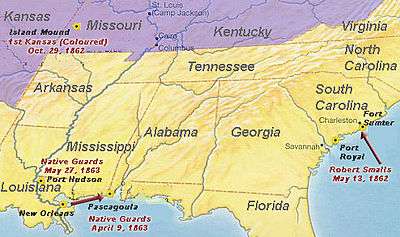Port Royal Experiment

The Port Royal Experiment was a program begun during the American Civil War in which former slaves successfully worked on the land abandoned by planters. In 1861 the Union liberated the Sea Islands off the coast of South Carolina and their main harbor, Port Royal. The white residents fled, leaving behind 10,000 black slaves. Several private Northern charity organizations stepped in to help the former slaves become self-sufficient. The result was a model of what Reconstruction could have been. The African Americans demonstrated their ability to work the land efficiently and live independently of white control. They assigned themselves daily tasks for cotton growing and spent their extra time cultivating their own crops, fishing and hunting. By selling their surplus crops, the locals acquired small amounts of property. In 1862, General Ormsby M. Mitchel allowed African Americans to found the town of Mitchelville on Hilton Head Island. In 1865 President Andrew Johnson ended the experiment, returning the land to its previous white owners.
In February 1862, a report was made to the Treasury Dept. which gives an indication of the territory held in the Port Royal Experiment:
An estimate of the number of plantations open to cultivation, and of the persons upon the territory protected by the forces of the United States, if only approximate to the truth, may prove convenient in providing a proper system of administration. The following islands are thus protected, and the estimated number of plantations upon each is given:
Island Plantations Port Royal 65 Lady's 30 Parry, including Horse 6 Cat 1 Cane 1 Datthaw 4 Coosaw 2 Morgan 2 St. Helena 50 Hilton Head 16 Pinckney 5 Bull, including Barratria 2 Daufuskie 5 Hutchinson and Fenswick 6 Total 195 Or about two hundred in all.
There are several other islands thus protected, without plantations, as Otter, Pritchard, Fripp, Hunting and Phillips. Lemon and Daw have not been explored by the agents engaged in collecting cotton. The populous island of North Edisto, lying in the direction of Charleston, and giving the name to the finest cotton, is still visited by the rebels. A part near Botany Bay Island is commanded by the guns of one of our war vessels, under which a colony of one thousand negroes sought protection, where they have been temporarily subsisted from its stores. The number has within a few days been stated to have increased to 2300.
---E. L. Pierce, The Negroes at Port Royal: Report of E. L. Pierce, Government Agent, to the Hon. Salmon P. Chase, Secretary of the Treasury, 1862[1]
See also
References
- ↑ American Antiquarian Society Online Resource: http://faculty.assumption.edu/aas/Reports/negroesatportroyal.html
- Faragher, John Mack, ed., The American Heritage Encyclopedia of American History, Henry Holt & Co., 1998.
- Foner, Eric. The Civil War and the Story of American Freedom. Art Institute of Chicago Museum Studies. 2001; 27(1):8-101.
- Ochiai, Akiko. The Port Royal Experiment Revisited: Northern Visions of Reconstruction and the Land Question. The New England Quarterly. 2001 Mar; 74(1):94-117.
- Rose, Willie Lee Nichols. Rehearsal for Reconstruction the Port Royal experiment. Athens: University of Georgia Press; 1999.
